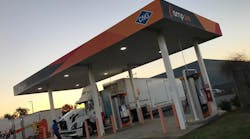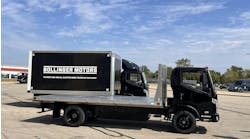Food service distributor US Foods is continually looking for ways to make its truck fleet run more efficiently. In an effort to do just that, and reduce its carbon footprint, the carrier has replaced 50 of its diesel-fuel tractors with compressed natural gas (CNG) units across its Texas fleet.
And later on this month, US Foods will officially serve as the anchor fleet for a new Amp Americas CNG station that will open in Buda, TX. That station will mark the 20th in the U.S. for Amp CNG.
“Our Texas fleet of 50 CNG units operating in place of similar diesel fuel tractors is estimated to reduce nitrogen oxide emissions by 70 tons,” explained Sara Matheu, director of media relations at US Foods. “It’s too soon to announce any new initiatives planned for 2018. We are excited about the up-and-coming opening of the Buda fueling station and look forward to the opportunities the site will provide.”
During a conversation with Fleet Owner, Grant Zimmerman, CEO of Amp Americas, explained that the economics of natural gas in commercial trucking are the best they’ve been in a few years.
“A CNG truck is more expensive than a diesel truck, but the fuel is much less expensive, and with diesel more than $3 a gallon, we see the economics of CNG at the sharpest point since then,” Zimmerman said. "That’s driven by diesel price going up.”
“We’re quite bullish on compressed natural gas for the next two years,” he added.
Part of the reason for the growth of natural gas and other alternative fuel options in the trucking sector is due to the Volkswagen diesel-emissions scandal settlement. As that settlement is being distributed, many states already have programs in place to use that money for emissions-reductions incentives.
Zimmerman also pointed out that CNG trucking is one of the big areas of focus for those incentive programs. In addition, states like California have earmarked spending incentives for cleaner transportation efforts to reduce NOx and other harmful greenhouse gas emissions.
Across the country, Zimmerman emphasized that the need for more natural gas vehicles and stations remains high. California alone needs tens, if not hundreds of thousands, of CNG or other alternative fuel trucks to meet its 2023 and beyond air quality goals, he noted.
“Transportation is the largest point cause of smog-causing pollution, and we can have a huge impact by converting a portion of the heavy-duty fleets to clean-burning natural gas,” Zimmerman said.
In addition to California, Amp Americas sees a need for additional natural gas infrastructure in Texas and across much of the East coast.
“The economics for CNG depend a bit on the local and the regional route structure and diesel prices, and diesel prices are the highest on the coast,” Zimmerman explained. “Then you have some of the best route running and some good incentives in natural-gas producing states, like Ohio, Pennsylvania, Texas, Colorado. So the market is quite supportive in those places, too.”
Over the last few years, when diesel prices were at record lows, Zimmerman explained that it was slightly more challenging to convince fleets to convert to natural gas. But now, he noted, fleets across the country are more well-versed in natural gas and other alternative fuel options.
“The conversation used to be, ‘how am I going to repair these things, where’s the refueling infrastructure, is the engine reliable,’” Zimmerman pointed out. “Now those hurdles have largely been overcome. Fleets are familiar with natural gas. They know that it’s a reliable engine.”
Nobody quite knows what’s going to happen on the regulatory front in Washington, but Zimmerman said he’s hearing increasing support from lawmakers on the Hill for reinstating the alternative-fuel tax credit. That, he said, would be a bonus for fleets already running alternative fuels and an even greater incentive for those considering making a change.




